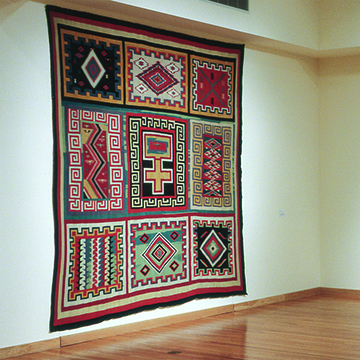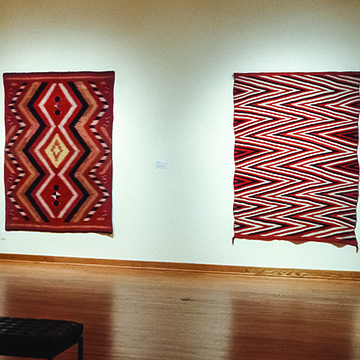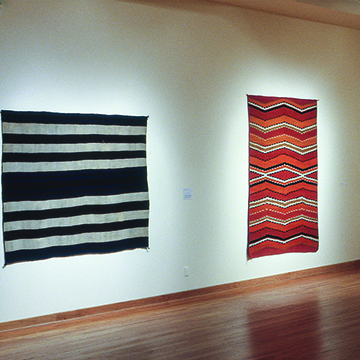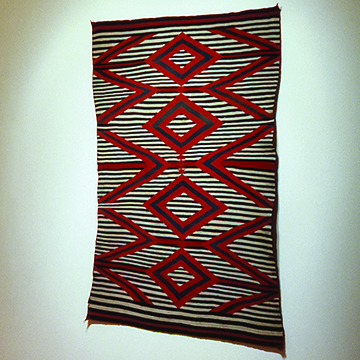Navajo Textiles: 1840-1910
When the Navajo culture first appeared in history, they were hunters, farmers and raiders, not weavers of cloth. But sometime, probably about the middle of the 17th century, the Navajo people learned to weave from the neighboring Pueblo people, and by the beginning of the 18th century, the Navajo weavers had adopted the Pueblo loom and were weaving enough cloth and garments for their own use and trading their surplus to Spanish and Pueblo people alike.
After the Spanish explorers finally gave up the idea of finding cities of gold in the New World and began instead to colonize the Southwest during the early 17th century, they brought with them silky-fleeced churro sheep, treadle looms and a long tradition of weaving. It was not long before yarns spun from Spanish sheep’s wool found their way into Pueblo weavings, says Joe Ben Wheat, curator emeritus of anthropology at the University of Colorado Museum, who wrote the essay for the accompanying gallery guide. The coming of the Spanish had another effect on Southwestern weaving. Many Pueblo Indians, fearful of repression by the Spaniards, fled to the Navajo homeland in the mountainous area north and west of Santa Fe and, through the 1600s, were incorporated into the burgeoning Navajo tribe. The Pueblo people had been weavers of cloth for over a thousand years, and in turn, taught the Navajo people to weave.
Early Navajo blankets were usually decorated with stripes of creamy white and shades of brown enriched by blue derived from indigo. The fineness of the weave and the sheep’s wool caused the blankets to drape naturally around the human form and lend it a certain elegance.
By the late 1800s, the Navajo weavers appear to have adapted designs from their basketry and began replacing stripes in their weaving with stepped-edge triangles in a rich contrast of colors. “No weaving in the Southwest has ever surpassed these fine serapes,” says Wheat. “From 1870 on, an increasing portion of Navajo weaving was not done for themselves, but for others – the military, the new settlers, and, finally, the tourists who began to visit the Southwest. Navajo blankets began to be used as floor covering. The transition that began about 1870, from blanket to rug, was virtually complete by 1900. The old weaving tradition ended as the new tradition of colorful Navajo rugs began.”
“Navajo blankets reflect a culture that was closely integrated with nature,” according to collector Tony Berlant, Santa Monica, California. “The women who wove them worked without drawings and patterns and believed that the Navajo deity, Spider Woman, inspired their weaving. Their blankets invite one to think about the extraordinary landscape they reflect, and about the people who wore them. Each blanket carries with it not only the vision of the Navajos as a culture but also the specific touch of an individual.”
Berlant will conduct a gallery walk on Sunday, Dec. 4. Works for the exhibition were lent from his collection.
The gallery guide essay was excerpted from Enduring Visions: 1,000 Years of Southwestern Indian Art, courtesy Aspen Art Museum, Aspen, Colorado.






